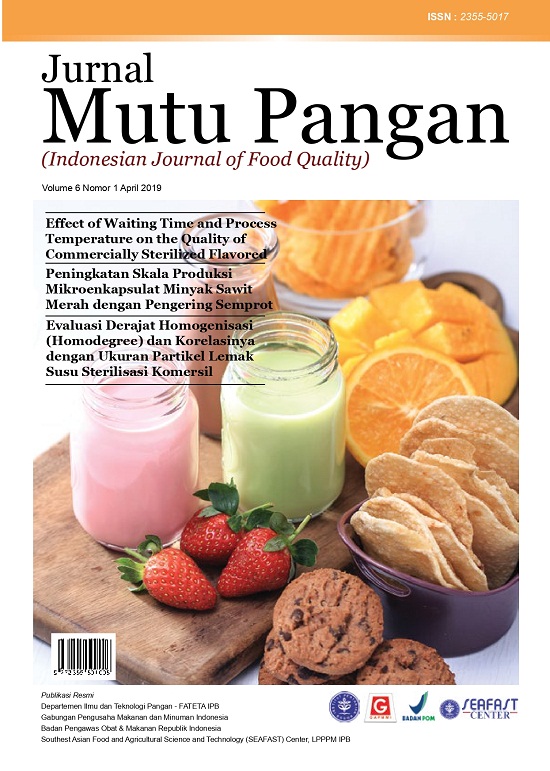Profil Komposisi BTP Campuran, Pelabelan, dan Penggunaannya pada Industri Rumah Tangga Pangan (IRTP) di DKI Jakarta
Abstract
Mixed food additives had been registered at BPOM since 2012. However regulation concerning mixed food additives was issued in 2016 and applied in 2017. The compliance assessment regarding registered mixed food additives has not been conducted so far. This research was aimed to identify composition and the use of mixed food additives as declared on label, evaluate its compliance with regulation and its use by home food industries in Jakarta. The secondary data regarding the composition of mixed food additives were obtained from BPOM, while the primary data regarding the decralation of mixed food additives were obtained from the market in DKI Jakarta. The results showed that 78% (494/632) registered mixed food additives were flavoring and colouring mixed food additive. The composition of mixed food additives divided into 3 part, namely the primary food additive which has a technological function in the final food product, the secondary food additive which has a technological function on mixed food additives and other ingredients that determine mixed food additives form (liquid, solid, powder, and paste/semisolid). The level of label sample complied with the regulation were 57% (49/86). Regarding to survey result on 18 home food industry, 7 were founded to use 16 kinds of mixed food additives. The application of 4 among these 16 kinds of mixed food additives were exceeded based on maximum limit of the regulation that had been stated by BPOM.Downloads
References
Blank I, Pascual EC, Devaud S, Fay LB. 2002. Degradation of the coffee flavour compound furfuryl mercaptan in model fenton-type reaction system. J Agr Food Chem 50(8): 2356-64. DOI: 10.1021/jf01 1329m.
[BPOM] Badan Pengawas Obat dan Makanan. 2001. Kodeks Makanan Indonesia. Jakarta: BPOM.
[BPOM] Badan Pengawas Obat dan Makanan. 2012. Peraturan Kepala Badan Pengawas Obat dan Makanan Republik Indonesia Nomor HK.03.1. 23.04.12.2205 Tahun 2012 Tentang Pedoman Pemberian Sertifikat Produksi Pangan Industri Rumah Tangga. Jakarta: BPOM.
[BPOM] Badan Pengawas Obat dan Makanan. 2013. Peraturan Kepala Badan Pengawas Obat dan Makanan Republik Indonesia Nomor 6 Tahun 2013 Tentang Batas Maksimum Penggunaan Bahan Tambahan Pangan Pembawa. Jakarta: BPOM.
[BPOM] Badan Pengawas Obat dan Makanan. 2016. Peraturan Kepala Badan Pengawas Obat dan Makanan Republik Indonesia Nomor 8 Tahun 2016 Tentang Persyaratan Bahan Tambahan Pangan Campuran. Jakarta: BPOM.
[BPOM] Badan Pengawas Obat dan Makanan. 2016. Peraturan Kepala Badan Pengawas Obat dan Makanan Republik Indonesia Nomor 22 Tahun 2016 Tentang Persyaratan Penggunaan Bahan Tambahan Pangan Perisa. Jakarta: BPOM.
[BPOM] Badan Pengawas Obat dan Makanan. 2017. Peraturan Kepala Badan Pengawas Obat dan Makanan Republik Indonesia Nomor 27 Tahun 2017 Tentang Pendaftaran Pangan Olahan. Jakarta: BPOM.
Cahyadi W. 2008. Analisis dan Aspek Kesehatan Bahan Tambahan Pangan. PT Bumi Aksara, Jakarta.
Dewayanti W, Muhamad H, Kadir A, Nappu MB. 2002. Pengaruh bahan penstabil terhadap mutu sari buah markisa. J Hortikultura 12(2): 110-117.
European Commission. 2011. Commission regulation (Eu) No 1130/2011 on amending annex III to regulation (EC) No 1333/2008 of the European Parliament and of the council on food additive, food enzyme, food flavourings and nutrients. J European Union 54(1): 178–204. DOI: 10.3000/19770677.L_ 2011.295.eng.
[FAO/WHO] Food and Agriculture Organization (FAO)/World Health Organization (WHO). 2015. Report of the Forty Seventh Session of the Codex Committee on Food Additives. http://www.fao. org/tempref/codex/Reports/Reports_2015/REP15_FAe.pdf.
Handayani SP, Nasoetion A, Sukandar D. 2008. Konversi satuan ukuran rumah tangga ke dalam satuan berat (gram) pada beberapa jenis pangan sumber protein. J Gizi Pangan 3(1): 49-60. DOI: 10.25182/jgp.2008.3.1.49-60.
Hausch B, Lorjaroenphon Y, Cadwallader KR. 2014. Flavor chemistry of lemon-lime carbonated beverages. J Agri Food Chem 63(1): 112-119. DOI: 10.1021/jf504852z.
[Kemenkes] Kementerian Kesehatan. 2012. Peraturan Menteri Kesehatan Nomor 33 Tahun 2012 Tentang Bahan Tambahan Pangan. Jakarta: Kemenkes.
Kumar R, Sharma PK, Mishra PS. 2012. A review on the vanilin derivatives showing various biological activities. J Pharmtech Res 4(1): 266-279.
Lee J, Chambers DH, Chambers E, Adhikari K, Yoon Y. 2013. Volatile aroma compounds in various brewed green teas. J Molecules 18(1): 10024-10041. DOI: 10.3390/molecules.
Nasution R. 2003. Teknik Sampling. http://www.library. usu.ac.id>fkm>fkm-rozaini.
Nugroho AI. 2014. Monitoring tetesan infus berbasis mikrokontroler atmega16. http://journals.ums.ac.id/ index.php/emitor/article/view/2056.
Pratiwi RP. 2018. Studi Bahan Tambahan Pangan dan Kesesuaian Label Kemasan pada Makanan Ringan Ekstrudat di Bogor. [Skripsi]. Bogor: Institut Pertanian Bogor.
Rahayu WP. 2011. Keamanan Pangan Kepedulian Kita Bersama. PT Penerbit IPB Press, Bogor.
Sevilla CD. 2007. Research Methods. Rex Printing Company, Quezon City.
Sjawil LN, Andarwulan N, Hariyadi P. 2014. Tren flavour produk pangan di Indonesia, Malaysia, Filipina, dan Thailand. J Mutu Pangan 1(1): 9-18.
Zhu G, Xiao Z. 2015. Study on creation of an indocalamus leaf flavour. J Food Sci Technol 35(4): 647-651. DOI: 10.1590/1678-457X.6770.

















